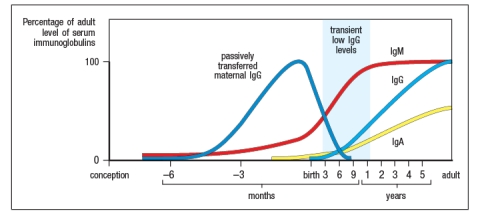Essay
Infants and young children with deficiencies in specific complement components present with recurrent respiratory infections caused by extracellular bacteria. The peak age of susceptibility is between 6 and 12 months after birth. At this time, as shown in Figure , maternal antibodies acquired by the child during fetal gestation are nearly gone, but the child is not yet generating robust antibody responses to new infections, as indicated by the low circulating levels of IgG and IgA. As children with this immunodeficiency get older, they outgrow this disease and show no further evidence of these recurrent infections. Based on this information, name one likely gene deficiency (in the complement system) that could cause this primary immunodeficiency, and the specific complement pathway likely to be affected. Explain your answer. 
Correct Answer:

Verified
MBL or MASP
Infants and small children ...View Answer
Unlock this answer now
Get Access to more Verified Answers free of charge
Correct Answer:
Verified
Infants and small children ...
View Answer
Unlock this answer now
Get Access to more Verified Answers free of charge
Q20: Patients with recurrent infections of Neisseria meningitidis,
Q21: Pseudomonas aeruginosa is a Gram-negative bacterium that
Q22: Our environment contains masses of microorganisms, many
Q23: Multiple pathways for regulating complement activation limit
Q24: One form of anemia results when individuals
Q26: The formation of the C3 convertase is
Q27: Several pathogens produce proteins, either membrane-bound or
Q28: The classical complement pathway is initiated by
Q29: The terminal components of the complement pathway
Q30: Four different clinical isolates of the Gram-positive